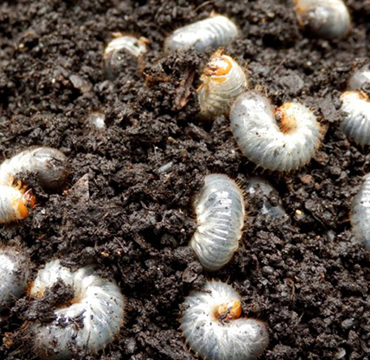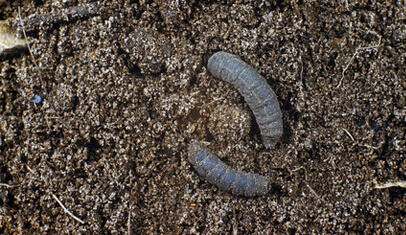Lawn grubs that you find in your lawn are baby insects – also known as larvae. Lawn grubs cause problems because they burrow through your soil eating your precious grassroots and destroying your garden as they go.
The most common time to find lawn grubs in your garden is during the summer months. The adult insects emerge at the start of summer to mate and then deposit their eggs back into the soil. Their eggs take a couple of weeks to hatch and once they do, they start feeding… on your lawn!
There are two types of common lawn grubs that you might come across in your garden; chafer grubs and leatherjackets. Here at Lawn & Weed Expert, we can help you eradicate both types of lawn grub and prevent damage. But first, let us tell you a bit about them.
Chafer Grubs

Lawn grubs in your garden
If you’re unfortunate enough to have an infestation of chafer grubs in your garden, it can be truly devastating for your lawn and other garden plants. It can be quite difficult to detect lawn grubs because they live and feed underground and barely come to the surface.
If you do happen to spot lawn grubs in your garden, we recommend contacting us for a free lawn survey so we can assess the extent of the infestation and start to treat it before these pesky lawn grubs cause you too many problems!
Identifying a chafer grub:
If you see any lawn grubs in your garden with the following characteristics, then it’s likely that you have a chafer grub infestation.
- 3 pairs of legs situated at the front of the body
- A distinctive light brown/orange coloured head
- Plump white body
Chafer grubs, like most lawn grubs, are eaten by foxes, badgers and a variety of birds including magpies and jackdaws. If you see any of these animals lingering suspiciously on your lawn and looking for food, it might be time to give us a call! For more information on our lawn grub control services, click the button below:
Chafer Grub Control Service >
Leatherjackets

Leatherjackets are baby crane flies – or crane fly larvae. You might be thinking, what’s a crane fly? Crane flies are much more commonly known by their nickname – Daddy Longlegs. During late autumn and early spring, these lawn grubs will feed ravenously on grass and plant roots, creating large patches of dry yellow grass as your lawn starts to die.
If you start to see these appearing, contact us for a free lawn survey to assess whether lawn grubs are causing the problem.
Identifying a leatherjacket:
If you spot a lawn grub with any of the following features, you might have a leatherjacket infestation in your garden.
- No obvious legs
- Brown/grey all over
- Mandibles at one end
Leatherjackets are often eaten by crows and magpies. So, if you see any of these birds flocking to your lawn then you should investigate to see if you can spot any lawn grubs and give us a call. We offer a comprehensive leatherjacket control service that will help keep your lawn grub free! Find out more here:
Leatherjacket Control Service >
While lawn grubs like these can be a particular nuisance, we know they aren’t the only type of pest you might find on your lawn! For all of our lawn pest & insect control services, simply click the button here: Lawn Pest & Insect Control Services >